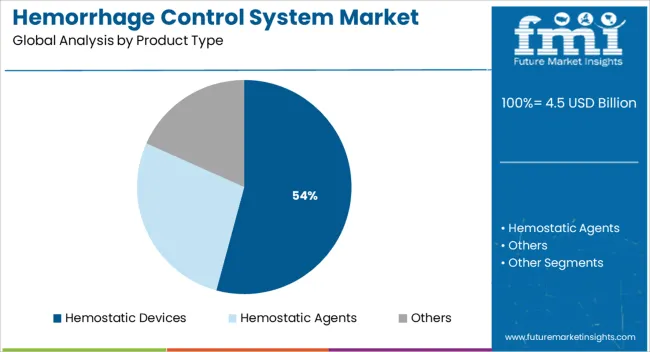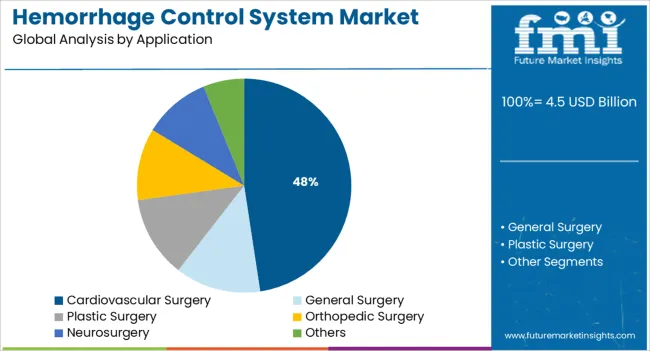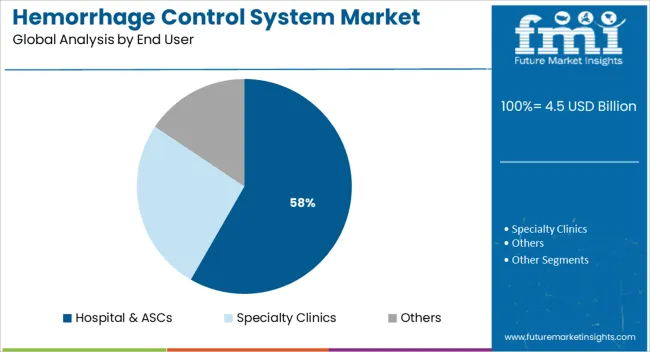The Hemorrhage Control System Market is estimated to be valued at USD 4.5 billion in 2025 and is projected to reach USD 6.0 billion by 2035, registering a compound annual growth rate (CAGR) of 3.0% over the forecast period.
Market Size and Share Forecast Outlook 2025 to 2035
| Metric | Value |
|---|---|
| Hemorrhage Control System Market Estimated Value in (2025 E) | USD 4.5 billion |
| Hemorrhage Control System Market Forecast Value in (2035 F) | USD 6.0 billion |
| Forecast CAGR (2025 to 2035) | 3.0% |
The hemorrhage control system market is advancing steadily due to the rising global burden of trauma, cardiovascular disorders, and surgical procedures that necessitate precise and effective bleeding management. With increasing emphasis on perioperative safety and clinical outcomes, healthcare providers are actively incorporating advanced bleeding control systems into their surgical protocols.
Technological innovations in device design, such as enhanced tissue compatibility and faster coagulation times, have strengthened adoption across emergency and elective care settings. Additionally, supportive government funding and institutional protocols focused on minimizing blood loss and transfusion reliance are accelerating market expansion.
The outlook remains robust as healthcare systems worldwide focus on reducing surgical complications, optimizing operative efficiency, and ensuring patient safety through the use of reliable hemorrhage control technologies.
The market is segmented by Product Type, Application, and End User and region. By Product Type, the market is divided into Hemostatic Devices, Hemostatic Agents, and Others. In terms of Application, the market is classified into Cardiovascular Surgery, General Surgery, Plastic Surgery, Orthopedic Surgery, Neurosurgery, and Others. Based on End User, the market is segmented into Hospital & ASCs, Specialty Clinics, and Others. Regionally, the market is classified into North America, Latin America, Western Europe, Eastern Europe, Balkan & Baltic Countries, Russia & Belarus, Central Asia, East Asia, South Asia & Pacific, and the Middle East & Africa.

The hemostatic devices segment is expected to represent 54.20%t of overall market revenue by 2025, making it the dominant product type. This prominence is driven by the devices’ ability to provide rapid clot formation, localized bleeding control, and improved hemodynamic stability during surgical interventions.
Hemostatic devices are widely preferred due to their versatility in open and minimally invasive procedures, particularly in trauma, orthopedics, and general surgery. Their ease of application, reduced procedural time, and lower risk of postoperative complications have made them essential tools in operating rooms.
Continued innovation in absorbable and biologically active agents is further enhancing their effectiveness, reinforcing their leadership within the hemorrhage control product landscape.

The cardiovascular surgery segment is projected to hold 47.60% of total revenue by 2025 within the application category, securing its position as the leading segment. This is due to the high incidence of cardiovascular diseases requiring surgical intervention and the associated risk of significant blood loss during such procedures.
Hemorrhage control systems play a critical role in these surgeries by ensuring rapid and controlled hemostasis, thereby reducing the need for blood transfusions and minimizing operative risks. As cardiac procedures become increasingly complex and patient volumes rise, the demand for reliable bleeding management systems continues to grow.
Hospitals and surgical centers are prioritizing advanced hemostatic solutions to enhance surgical outcomes and reduce recovery time in cardiovascular patients, supporting this segment’s leading status.

Hospitals and ambulatory surgical centers are expected to contribute 58.30% of the market’s total revenue by 2025, making this the dominant end user segment. This growth is driven by the high volume of surgeries performed in these settings and the need for standardized bleeding control protocols across diverse surgical disciplines.
These facilities have the infrastructure, clinical expertise, and procurement capability to adopt advanced hemorrhage control systems. Furthermore, increasing healthcare expenditure, improved surgical capacities, and ongoing staff training initiatives are supporting the deployment of specialized devices in these environments.
As regulatory and accreditation standards increasingly emphasize intraoperative safety and patient outcomes, hospitals and ASCs remain the primary setting for hemorrhage control system utilization.
The preference for hemorrhage control systems is escalating due to significant growth aspects such as an increase in laparoscopic surgery, an increase in athletics injuries, and an increasing prevalence of chronic illnesses such as cardiovascular, orthopedic, and trauma throughout the world. The increased number of surgical operations can result in a variety of problems, including bleeding, which is expected to drive demand for hemorrhage control systems throughout the forecast period.
Healthcare establishments are likely to adopt hemorrhage control systems more frequently. Owing to the rising amount of severe war injuries, the hemorrhage control system sector is flourishing. Furthermore, the expansion of the hemorrhage control system market is related to regulatory clearance for marketing the product in various nations.
Some other primary determinants expected to boost the global hemorrhage control systems market over the forecast period are rapid technological advancements, rising healthcare expenditures, a desire to adopt novel solutions for emergency medical treatment, and the entry of new manufacturers.
An increasing number of injuries caused by trauma, which has a greater probability of nerve damage, is expected to encourage healthcare practitioners to provide patients with prompt treatment. This is among the key tenets that will stimulate hemorrhage control systems sales in the coming days.
The global hemorrhage control system market is growing due to ongoing development. Several hemorrhage control system manufacturers in the post-pandemic era work with a feeling of immediacy and consumer attention. Attempts to cut costs across the value chain to offer products at affordable pricing. Furthermore, manufacturers have realized that long-term performance depends on continuing innovation and customer-focused initiatives, as well as upgrading and expanding production.
The key players in the market are engaged in the research and development of treatments and medications for hemorrhage control systems. Attempts of manufacturers to improve the effectiveness of these hemorrhage control systems, as well as packaging solutions and safety regulations, will render these products convenient and more commonly accepted.
Hemorrhage control systems are designed by manufacturers to supply professional caregivers with the materials they need to halt life-threatening bleeding. These are designed to provide immediate access to life-saving products capable of controlling catastrophic hemorrhaging and bleeding. These can substantially mitigate severe bleeding from every sort of severe injury. These systems are successful in sealing the edges of a wound to form a temporary hematoma under pressure, which reduces blood loss during or after surgery essentially.
The global hemorrhage control system market is estimated to be valued at USD 4.5 billion in 2025.
The market size for the hemorrhage control system market is projected to reach USD 6.0 billion by 2035.
The hemorrhage control system market is expected to grow at a 3.0% CAGR between 2025 and 2035.
The key product types in hemorrhage control system market are hemostatic devices, hemostatic agents and others.
In terms of application, cardiovascular surgery segment to command 47.6% share in the hemorrhage control system market in 2025.






Our Research Products

The "Full Research Suite" delivers actionable market intel, deep dives on markets or technologies, so clients act faster, cut risk, and unlock growth.

The Leaderboard benchmarks and ranks top vendors, classifying them as Established Leaders, Leading Challengers, or Disruptors & Challengers.

Locates where complements amplify value and substitutes erode it, forecasting net impact by horizon

We deliver granular, decision-grade intel: market sizing, 5-year forecasts, pricing, adoption, usage, revenue, and operational KPIs—plus competitor tracking, regulation, and value chains—across 60 countries broadly.

Spot the shifts before they hit your P&L. We track inflection points, adoption curves, pricing moves, and ecosystem plays to show where demand is heading, why it is changing, and what to do next across high-growth markets and disruptive tech

Real-time reads of user behavior. We track shifting priorities, perceptions of today’s and next-gen services, and provider experience, then pace how fast tech moves from trial to adoption, blending buyer, consumer, and channel inputs with social signals (#WhySwitch, #UX).

Partner with our analyst team to build a custom report designed around your business priorities. From analysing market trends to assessing competitors or crafting bespoke datasets, we tailor insights to your needs.
Supplier Intelligence
Discovery & Profiling
Capacity & Footprint
Performance & Risk
Compliance & Governance
Commercial Readiness
Who Supplies Whom
Scorecards & Shortlists
Playbooks & Docs
Category Intelligence
Definition & Scope
Demand & Use Cases
Cost Drivers
Market Structure
Supply Chain Map
Trade & Policy
Operating Norms
Deliverables
Buyer Intelligence
Account Basics
Spend & Scope
Procurement Model
Vendor Requirements
Terms & Policies
Entry Strategy
Pain Points & Triggers
Outputs
Pricing Analysis
Benchmarks
Trends
Should-Cost
Indexation
Landed Cost
Commercial Terms
Deliverables
Brand Analysis
Positioning & Value Prop
Share & Presence
Customer Evidence
Go-to-Market
Digital & Reputation
Compliance & Trust
KPIs & Gaps
Outputs
Full Research Suite comprises of:
Market outlook & trends analysis
Interviews & case studies
Strategic recommendations
Vendor profiles & capabilities analysis
5-year forecasts
8 regions and 60+ country-level data splits
Market segment data splits
12 months of continuous data updates
DELIVERED AS:
PDF EXCEL ONLINE
Control Network Modules Market Size and Share Forecast Outlook 2025 to 2035
Controllable Shunt Reactor for UHV Market Size and Share Forecast Outlook 2025 to 2035
Control Room Solution Market Size and Share Forecast Outlook 2025 to 2035
Control Knobs for Panel Potentiometer Market Size and Share Forecast Outlook 2025 to 2035
Controlled-Release Drug Delivery Technology Market Size and Share Forecast Outlook 2025 to 2035
Controlled Environment Agriculture (CEA) Market Size and Share Forecast Outlook 2025 to 2035
Control Cable Market Size and Share Forecast Outlook 2025 to 2035
Control Towers Market Size and Share Forecast Outlook 2025 to 2035
Controlled & Slow Release Fertilizers Market 2025-2035
Controlled Intelligent Packaging Market
Biocontrol Solutions Market Size and Share Forecast Outlook 2025 to 2035
Biocontrol Agents Market Size and Share Forecast Outlook 2025 to 2035
Oil Control Shampoo Market Size and Share Forecast Outlook 2025 to 2035
LED Control Unit Market Size and Share Forecast Outlook 2025 to 2035
Sun Control Films Market Size and Share Forecast Outlook 2025 to 2035
CNC Controller Market Size and Share Forecast Outlook 2025 to 2035
PID Controller Market Size and Share Forecast Outlook 2025 to 2035
Market Share Breakdown of Sun Control Films Manufacturers
PLC Controlled Packing Machine Market Trends – Forecast 2024-2034
Seat Control Module (SCM) Market Forecast and Outlook 2025 to 2035

Thank you!
You will receive an email from our Business Development Manager. Please be sure to check your SPAM/JUNK folder too.
Chat With
MaRIA